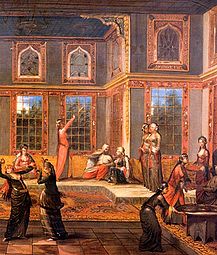後宮 (伊斯蘭)
外觀

伊斯蘭世界的後宮(阿拉伯語:حرم),本義為禁止之地,神聖密室。起源於近東,包括阿拉伯帝國的倭馬亞王朝與阿拔斯王朝、伊朗的薩法維王朝、印度的蒙兀兒帝國與土耳其的鄂圖曼帝國等皇室。並通過鄂圖曼帝國傳入西方世界。指在一夫多妻制環境下的女性以及未成年兒子的居住場所,禁止成年男性進入。
奧地利作曲家莫扎特曾以鄂圖曼帝國後宮為題材創作歌劇《後宮誘逃》。歐洲畫家經常以有關主題作為題材(參看東方主義)。日本動漫中的「後宮型作品」中的後宮一詞就來源於此概念。
鄂圖曼帝國
[編輯]鄂圖曼帝國時期,蘇丹的後宮,等級秩序嚴謹,以在位蘇丹的母親(稱蘇丹皇太后)地位最高並擁有絕對的權力,有部分蘇丹皇太后甚至能代替蘇丹本身執掌國政。在鄂圖曼帝國初期,蘇丹的四位正妻稱蘇丹后,其之下有多個級別的妃嬪,最高為可敦,再之下依次夫人(土耳其語:Kadın[a])、幸人(土耳其語:Ikbal)[b]、睞人(土耳其語:Gözde)[c]等。後來改制,正妻改稱皇后(土耳其語:Kadınefendi),廢除可敦位號,其他妃嬪位號不變。嫡子繼位後,其生母會被尊為蘇丹皇太后,若由庶子繼位,其生母不得尊為皇太后,有些會由其中一位嫡母作為養母尊為蘇丹皇太后。
後宮中有多名不同等級的宮女,負責不同職務。
圖庫
[編輯]- 伊斯蘭後宮的相關繪畫作品
-
The Pasha in His Harem by Francois Boucher c. 1735-1739
-
Scene from the Harem, Jean-Baptiste van Mour (1st half of the 18th century)
-
Scene in a Harem, by Guardi
-
The Harem as imagined by European artist, The Dormitory of the Concubines, by Ignace Melling, 1811.
-
Gustave Boulanger: The Harem
-
Harem scene by Dominique Ingres
-
The Reception, John Frederick Lewis, 1805-1875, English
-
Scene from the Harem by Fernand Cormon, c. 1877
-
Harem Scene, Quintana Olleras, 1851-1919, Spanish
-
The Harem Fountain, Frederick Arthur Bridgman, 1847-1928, American
-
Belle of Nelson whiskey poster (1878), based on a harem scene by Jean-Léon Gérôme.
-
In the harem, Lehnert & Landrock postcard, 1900s-1910s
-
The Virgin of Stamboul, 1920 film poster
參看
[編輯]注釋
[編輯]
參考書目
[編輯]- Hans Wehr. A Dictionary of Modern Written Arabic: (Arabic-English), 4th ed. Spoken Language Services, 1994, s.v. حرم.













